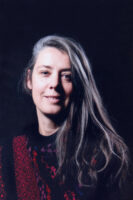
Marta Bogdanska
Q&A: Marta Bogdanska
26.3.24
We caught up with Polish artist Marta Bogdanska to discuss her body of work SHIFTERS, on display in the exhibition 'Only the future revisits the past' at the Centre for Contemporary Photography as part of PHOTO 2024, and continuing until 12 May 2024.
Hello Marta, please start by telling us a bit about yourself.
Hey everyone, I am Marta and I am a Polish visual artist, photographer and filmmaker. My background and my practice are both quite diverse, as I use various media and tools in my work. I have a MA in Philosophy but I also studied gender studies, photography and took part in many experimental art programs. I love to learn myself!
My projects are often based on long-term research (for example archival one) and investigate complex topics related to animal agency, new perspectives in history, queer and social issues. Moreover, I like to collaborate and to include participatory elements in my projects, which I think stems from my activist background. When I was a kid my family moved to stay in the middle of Sahara, which had a huge influence on me. I also lived in Lebanon for eight years.
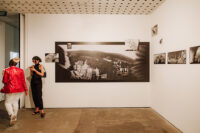
Marta Bogdanska, SHIFTERS (2024) PHOTO2024 installation view, Centre for Contemporary Photography. Photo by William Hamilton-Coates.
We’re excited that 'SHIFTERS' will be exhibited as part of Only the Future Revisits the Past show the Centre for Contemporary Photography as part of PHOTO 2024. What’s the story behind this project?
SHIFTERS is a long-term research-based project that investigates the animal perspective in history of Western military and spy programmes. Following the concept coined by French historian Éric Baratay it tries to look for “animal point of view” and ways in which we can re-tell history including their experiences, agency and event-shaping presence.
The images come from the Internet and are often low quality, copies of copies. This is a deliberate choice to use what Hito Steyerl calls “poor images” to see how a valid narrative can be created from such bastard imagery. Based on extensive collection of archival images and materials the project consists of an award winning book, video essay, audio workshops and “Sound Stories” created during those, texts, and even objects. Each presentation, installation and show is different.
Do you have a favourite photograph of the works showing? Tell us a bit about it.
Favourite image from SHIFTERS? Well, I do not really have one, I love this project deeply and the abundance of materials, photographs is on one hand overwhelming but so enriching! Maybe I would like to mention though a photograph that I found in the Library of Congress. It is a portrait of a cat dressed in Viking armour and helmet and entitled “Brunhilde”. It was taken by Adolph E. Weidhaas in 1936. This image is on the cover of my book, and it has been there since my first dummy. I chose it instinctively. It is only later that me and my curators Anna Bas and Karolina Wroblewska-Lesniak started looking into stories around that picture for one of my first big solo shows at Krakow Photomonth in 2021.
We wrote a whole “animal biography” for Brunhilde, as she is a mythical creature from Scandinavian mythology. She was a Valkyrie, a beautiful female fighter for Odin. She lived in Walhalla but she could go down to Earth if she took on a form of a swan. There is an opera written by Wagner about Brunhilde and her tragic story. So, I chose this picture as a cover for the project intuitively and it was the best choice ever: Brunhilde is the ultimate shape-shifter and the perfect guide for the story! It also turned out that this image is the most dowloaded one from LOC. Last year, on January 1st 2023, Library of Congress released a second photograph of Brunhilde, in a slightly different pose. I already showed it in a couple of exhibitions.
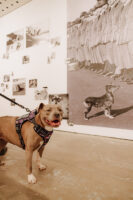
Marta Bogdanska, SHIFTERS (2024) PHOTO2024 installation view, Centre for Contemporary Photography. Photos by William Hamilton-Coates.
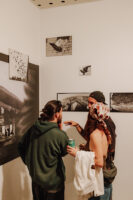
Where do you draw inspiration for your work? Can you explain your artistic process?
I am inspired by so many things! It can be an article, an image, something I read… SHIFTERS came to life actually because of a series of articles I came across while living in Beirut. They were about animal spies and agents. They were just your typical stories in mainstream media. I started collecting those and little did I know how this will change my life.
I am a slow cooker: I develop projects patiently, they often require a lot of research and they grow on me and with me. I once took part in a workshop with Vanessa Winship and she taught me to trust my process, to cherish the slow brewing of it. I mean it is not always the same, it can change, depending on the project and the situation. I do think a lot. I tend to use various tools, I am a storyteller and I feel that a story just becomes richer if I express it in various ways. That is why I am more of a visual artist: in SHIFTERS you have a combination of research, archive, book, video essay, audio workshops, sound stories created during those, texts and even objects.
Additionally every exhibition and installations is very different, there are multiple topics and themes in the project that can be explored, I often create site-specific works; for example a 16 m photo collage for Thessaloniki Photobiennale last year. I also collaborate and try to have participatory aspects in my projects. I learn new things and this feeds back into my work. It might be, in some cases, a never-ending process!
What do you hope viewers take away? What kind of responses does your work typically receive?
I hope that viewers can take away questions. That they will stop and reflect even for a moment, and manage to look at things in a different way. I also hope that I can spark their interest. Well, I do not try to lecture or be didactic in my projects. I have my own strong opinions but in my artwork I try to convey nuanced story. One of the recurring themes in my practice is the re-telling of history and bringing to light forgotten or neglected perspectives (be it queer points of view, animal history or including perspectives of migrant community), and therefore my art is socially engaged for sure.
I think that what I do is this: I try to re-shape the narratives, look at archives in a new way, find hidden power structures and question hegemonic discourses. I do get good responses to my artwork, people get interested, drawn into it, they discover things they forgot or see them in a new light. Oftentimes I build my projects in a way that they hook you first or offer an entry point, with some sensational and super interesting idea (like SHIFTERS with the idea of animal spies), but then the deeper you go the more complex, nuanced and critical it all becomes.
The theme for PHOTO 2024 is ‘The Future Is Shaped by Those Who Can See It’. What comes to mind for you when you consider that theme?
It is a very relevant and important theme and I think it summarises our situation very well. We have been warned by scientists about the climate catastrophe for years, they have seen it, they know it is coming, they are sounding the alarms! They are the ones who can see it. Some people are waking up. We have activism, we have people revolting against the exploitation and destruction of life on this planet. The question is how to make everyone see it? How to overcome the feeling of helplessness in people and convince them we can still fight? How to destroy the hypocrisy of our capitalistic life and elites, who do not see beyond their benefits and profit? I strongly believe that we need to work on many levels.
Activism and political lobbying is one, but changing the metaphors and narratives about our lives, our coexistence with nature and other animals, and the planet, is needed very much as well. This is where art, in all its forms, comes in: we have the responsibility to face the truth and help shape new ways of relating to our future (if we still want to have one). Even working with archives, which are of course all entangled in power relations, can offer us new ways of giving justice to other-than-human animals and their experiences for example. There is so much to do.
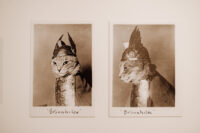
Marta Bogdanska, from the series SHIFTERS (2024),Centre for Contemporary Photography, PHOTO2024. Photo by William Hamilton-Coates.
How do you navigate the intersection of technology and art in the field of photography?
I have never been a very traditional or one genre photographer. I use various tools within photography itself, so for me it is about learning and understanding what works for me, what works in a specific project or context, what can be gained form using one technology or the other etc. I can use digital camera and right next to it take analogue pictures with my Mamiya. I am not a purist in that sense. Nor a gear geek.
What other exhibitions or artists were you interested in seeing at PHOTO 2024?
I wish I could see everything, really! I would love to check out our show at CCP of course, and the whole Queer Photo section. Amos Gebhardt, Michael Najjar, ನಿರೀಕ್ಷಣೆ nireekshane, Fiona Amundsen, Anne Zahalka, Jana Hartmann… But honestly, it is going to be a feast, everything’s just looks rad!
Unfortunately I will not be in Melbourne, as we were not able to find funding for my coming to your amazing Festival even though we have tried really hard since June 2023.
Such a shame!
If your project was a song, what would it be?
I love this question. I actually do work more and more with sound. I have created author workshops for SHIFTERS which combine storytelling and audio. We do create sound pieces as I think that it helps to look differently at animal agency and experiences, helps us perceive them differently. We have created some pretty intense audio pieces in our workshops. Some give you goose bumps. They enter into dialog with the images, open up new interpretations, and even go beyond the photographs. If I were to say that my work was one song or one sound piece I would go with a futuristic other-then-human animals’ orchestra.
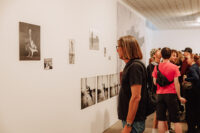
Marta Bogdanska, SHIFTERS (2024) installation view, Centre for Contemporary Photography, PHOTO2024. Photo by William Hamilton-Coates.
What advice would you give your 15 year self?
I could give myself at least a few advices. Both on a personal level and on the professional one. To trust myself more and follow my ideas. But also to be easy on myself and treat myself with more care and understanding. You can always change and do new things. I became an artist five years ago, sometimes things need the right timing and state of mind.
Anything else you’d like people to know?
I have been working on a new project entitled “Vive la Résistance!”, which follows up on some of the questions and themes that SHIFTERS raised for me. It is again a long-term research based multimedia project, which includes much more audio works, experimental videos, objects… and I hope I will be able to start sharing it with you all soon!
Only the future revisits the past is on display at Centre for Contemporary Photography until 12 May 2024.